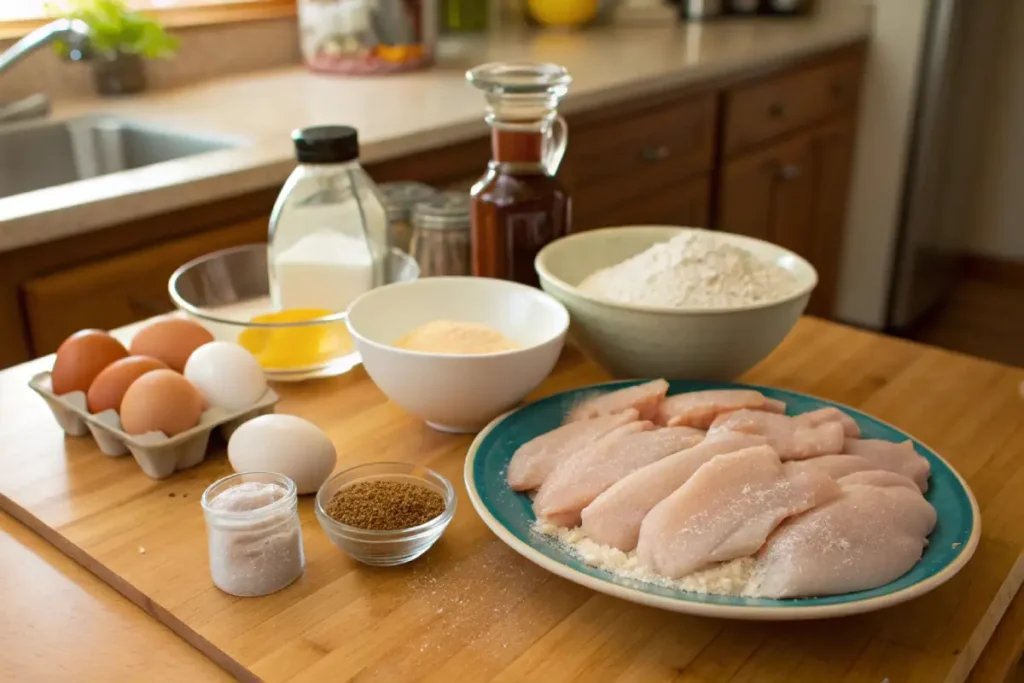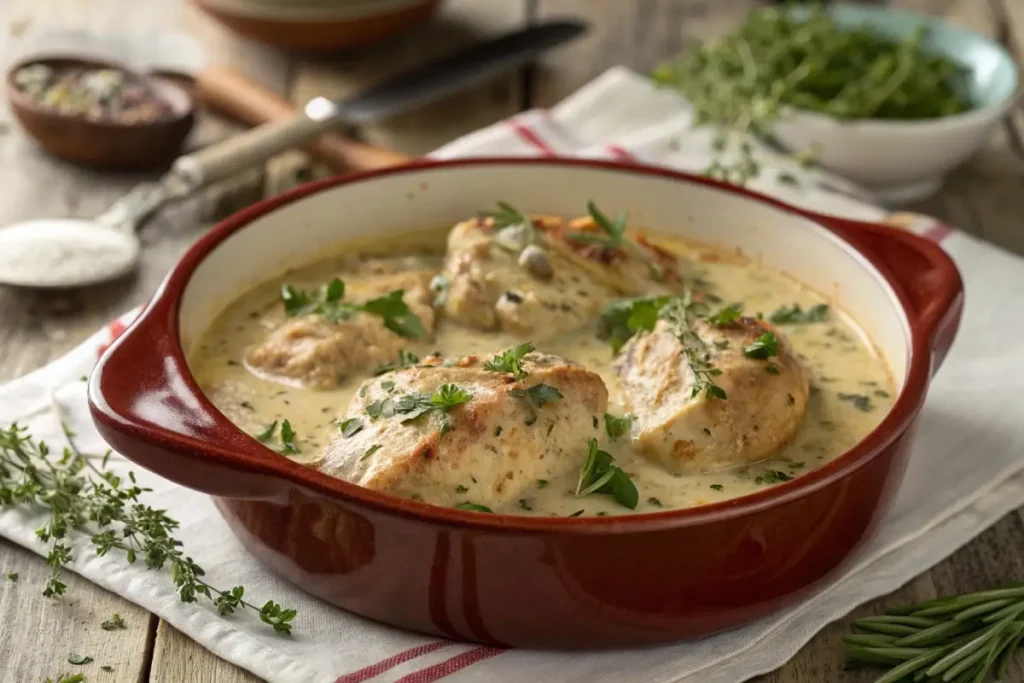You know that disappointing moment when you take a bite of chicken, expecting juicy perfection, but instead, it’s dry and tough? Yeah, we’ve all been there! But don’t worry—you’re about to discover what is the secret to making chicken tender? It’s not just about cooking time; it’s about using the right techniques and ingredients to transform your chicken into a mouthwatering, melt-in-your-mouth delight. Whether you’re making a quick weeknight dinner or impressing guests, mastering tenderness will take your cooking to the next level.
The best part? It’s easier than you think! With a few simple tricks, like marinating in yogurt, cooking at the right temperature, and avoiding common mistakes, you’ll never have to deal with rubbery chicken again. Plus, these methods work with any recipe—grilled, baked, or pan-fried. Ready to level up your chicken game? Keep reading, and let’s turn every meal into a tender, juicy masterpiece!
Table of Contents
Understanding the Science Behind Tender Chicken
How Protein and Fat Content Affect Texture
Chicken texture depends on its protein and fat balance. Protein gives structure, while fat adds moisture. Lean cuts, like chicken breast, have less fat, making them more prone to dryness. Dark meat, such as thighs, contains more fat, keeping it juicier.
When cooking, proteins tighten and squeeze out moisture. The trick is to control the heat. High heat causes rapid tightening, making the meat tough. Low, slow cooking keeps proteins relaxed, preserving juiciness. Fat also plays a role by coating proteins and reducing moisture loss.
Here’s a comparison of chicken cuts:
| Chicken Cut | Fat Content | Texture When Cooked | Best Cooking Method |
|---|---|---|---|
| Breast | Low | Can be dry | Marinate & bake/grill |
| Thigh | Medium | Juicy & tender | Slow cook/stir-fry |
| Drumstick | Medium-High | Moist & flavorful | Roast/grill |
Using the right cut and cooking method makes all the difference.
The Role of Collagen Breakdown in Softening Meat
Collagen is a tough protein found in chicken. When heated slowly, it turns into gelatin, making meat soft and juicy. Tougher cuts, like drumsticks and wings, have more collagen. They need longer cooking times to break down properly.
Collagen starts breaking down at 160°F (71°C) and turns into gelatin around 180°F (82°C). This is why slow-cooking methods, like braising, work best. Rushing the process leads to chewy meat.
Here’s a quick look at collagen breakdown:
| Cooking Temperature | Effect on Collagen | Texture Outcome |
|---|---|---|
| 140°F (60°C) | Collagen intact | Tough |
| 160°F (71°C) | Starts breaking | Slightly tender |
| 180°F (82°C) | Gelatin forms | Soft & juicy |
To get the most tender chicken, cook it low and slow, allowing collagen to work its magic!
Essential Techniques for Tenderizing Chicken
The Benefits of Marinating with Natural Enzymes
Marinades do more than add flavor—they help break down proteins, making chicken tender. Natural enzymes in foods like pineapple, papaya, and ginger soften meat by breaking down tough fibers. If you’re looking for a delicious way to apply this technique, check out this Crack Chicken Tenders Recipe, which uses the right seasoning and cooking methods for irresistibly juicy results.
Here’s a look at effective natural tenderizers:
| Ingredient | Enzyme | Best for |
|---|---|---|
| Pineapple | Bromelain | Quick tenderizing (1-2 hours) |
| Papaya | Papain | Strong tenderizing (30 mins) |
| Ginger | Zingibain | Gentle tenderizing (2-3 hours) |
To avoid mushy chicken, don’t over-marinate! Keep it under four hours for the best results.
Proper Cooking Methods to Retain Juiciness
Cooking chicken the right way keeps it tender and delicious. Here’s what you should do:
- Use gentle heat – Cooking too fast makes chicken dry.
- Cover while cooking – Traps moisture and prevents dryness.
- Let it rest – Resting for 5-10 minutes helps juices spread evenly.
- Slice against the grain – Cutting meat the right way makes each bite softer.
If you’re a fan of grilled chicken, try this Grilled Chicken Wrap Recipe, where the right grilling method ensures a moist and flavorful bite every time.
The Best Ingredients for What is the Secret to Making Chicken Tender?
Acidic Marinades and Their Impact on Meat Fibers
Acids help break down proteins, making chicken softer. Vinegar, citrus juice, and yogurt are great for this. They create space between protein fibers, helping moisture stay inside.
Here’s how different acids work:
| Ingredient | Effect on Meat | Best Use |
|---|---|---|
| Lemon Juice | Quick tenderizing | Grilled & baked chicken |
| Vinegar | Deep penetration | Slow-cooked dishes |
| Yogurt | Gentle softening | Kebabs & tandoori chicken |
Using the right acid in your marinade makes chicken flavorful and tender.
Dairy-Based Tenderizers: How Yogurt and Buttermilk Work
Dairy marinades work differently from acidic ones. They contain lactic acid, which gently softens meat without making it mushy. Buttermilk and yogurt also add creaminess, making chicken even juicier.
Why use dairy marinades?
- Slow, even tenderizing – Less risk of over-softening.
- Extra flavor – Adds a mild tangy taste.
- Moisture lock – Creates a protective layer to retain juiciness.
Soaking chicken in yogurt or buttermilk for 4-12 hours gives the best results. It’s perfect for frying or grilling!

The Right Cooking Temperatures for Juicy Chicken
The Importance of Low and Slow Cooking
Cooking chicken at low temperatures keeps it tender. High heat makes proteins tighten too quickly, leading to dryness. Instead, slow cooking allows moisture to stay inside.
Here’s a simple temperature guide:
| Cooking Method | Ideal Temperature | Cooking Time |
|---|---|---|
| Slow Cooker | 165-180°F (74-82°C) | 4-6 hours |
| Oven Roasting | 325°F (163°C) | 45-60 minutes |
| Grilling (Indirect Heat) | 350°F (177°C) | 20-30 minutes |
For an example of how slow roasting can yield incredibly juicy chicken, take a look at this Galena Chicken Recipe, which showcases the best seasoning and cooking techniques for tenderness.
Cooking slowly at the right temperature keeps every bite soft and juicy!
Using a Meat Thermometer for Perfect Doneness
A meat thermometer prevents overcooking by ensuring the right internal temperature. Always check the thickest part of the chicken for accuracy.
Here’s what to look for:
- White meat (breast): 165°F (74°C)
- Dark meat (thighs, drumsticks): 175-180°F (79-82°C)
- Stuffed chicken: 165°F (74°C) inside stuffing
Using a thermometer takes the guesswork out of cooking. It ensures your chicken stays safe and perfectly tender every time!
“Now that you know the secrets to making chicken irresistibly tender, it’s time to put that knowledge to work! Grab your apron because this Slow-Cooked Buttermilk Herb Chicken is about to take your taste buds on a juicy, flavorful ride. Let’s get cooking!”
Slow-Cooked Buttermilk Herb Chicken
Ingredients
Great chicken starts with the right ingredients. Each one plays a role in making your dish tender, juicy, and packed with flavor. Let’s break it down!
- Buttermilk (2 cups / 475ml) – This is the ultimate secret weapon for tender chicken! Buttermilk’s natural acids gently break down the meat fibers, making each bite soft and juicy. Plus, it adds a subtle tang that makes the chicken extra flavorful.
- Salt (2 tablespoons + ½ tablespoon for rubbing) – Salt isn’t just for seasoning. It helps draw moisture into the meat, locking in juiciness. Also, a little extra on the skin creates that crispy, golden-brown crust!
- Whole Chicken (3 to 4 pounds) – The star of the dish! Using a whole chicken means you get both light and dark meat, each with its own delicious texture. The buttermilk brine keeps every part equally tender.
- Salted Butter (1 stick / ½ cup / 4oz / 113g, softened) – Butter under the skin creates an extra-rich, melt-in-your-mouth bite. It bastes the chicken as it roasts, keeping it from drying out.
- Rosemary (1 sprig, finely chopped) – This herb is bold and fragrant. It adds an earthy, slightly piney flavor that pairs perfectly with roasted chicken.
- Thyme (5 sprigs, leaves removed) – Thyme is light and citrusy, bringing a fresh balance to the rich butter and chicken.
- Sage (5 leaves, finely chopped) – Sage has a deep, savory flavor that gives the chicken a cozy, comforting taste. It’s like a warm hug in every bite!
- Garlic (1 minced clove for butter + 6 whole cloves for stuffing) – Garlic does double duty in this recipe. The minced garlic in the butter adds richness, while the whole cloves inside the chicken infuse it with a deep, roasted flavor.
- Lemon (1 whole, pierced with a fork) – Stuffing the chicken with a whole lemon adds moisture and a gentle citrusy zing. As it roasts, it steams the chicken from the inside out, keeping it extra juicy.
- Herb Poultry Mix (a handful of rosemary, thyme, and sage) – These fresh herbs bloom in the oven, releasing their oils and creating a deeply aromatic chicken that smells as good as it tastes!

Step-by-Step Instructions
This recipe is as easy as it is delicious. Follow these steps, and you’ll have perfectly tender chicken in no time!
1. Brine the Chicken in Buttermilk
First, mix the buttermilk and salt in a large bowl. Place the chicken into a big ziplock bag or deep dish. Pour the buttermilk over the chicken, making sure it’s fully coated. Next, seal the bag and massage it gently to spread the marinade evenly. Let it chill in the fridge for at least 4 hours, but overnight is even better. This step is key for super juicy meat!
2. Prep the Chicken for Roasting
Once you’re ready to cook, take the chicken out of the fridge. Over the sink, let the excess buttermilk drip off. Discard the marinade, then place the chicken on a foil-lined tray. Pat it dry with paper towels—this helps the skin crisp up beautifully in the oven!
3. Make and Apply the Garlic Herb Butter
In a small bowl, mix butter, rosemary, thyme, sage, garlic, and black pepper. Carefully loosen the skin from the breast using a spoon. Then, spread the herb butter underneath. This melts into the meat as it cooks, keeping it incredibly moist.
4. Stuff and Season the Chicken
Now, let’s pack in even more flavor! Stuff the cavity with whole garlic cloves, fresh herbs, and the pierced lemon. This creates a natural steam inside the chicken, making it tender and aromatic. Then, rub extra salt onto the skin for an even crispier, golden-brown finish.
5. Roast to Perfection
Preheat the oven to 390°F (200°C). Place the chicken on a baking sheet and roast uncovered for 1 to 1 hour 15 minutes. Rotate the pan every 20 minutes to ensure even browning. Once it reaches 160°F (71°C) in the thigh, take it out—it will continue cooking up to 165°F (74°C) as it rests. Let it sit for at least 15 minutes before carving. This step locks in all the juices!
Serving
This buttermilk roasted chicken is a showstopper! It serves 4 to 6 people and is perfect for any occasion.
- Classic Style: Serve it with buttery mashed potatoes and a crisp green salad.
- Rustic Touch: Pair it with roasted veggies and warm dinner rolls for a cozy meal.
- Creative Twist: Shred it and serve in sandwiches, wraps, or salads for easy meals throughout the week!
For extra flair, garnish with fresh thyme and a squeeze of lemon juice before serving. It makes everything pop with flavor!
Tips and Hacks
Want to make this recipe even better? Here are a few pro tips!
- Let the chicken warm up before cooking – Take it out of the fridge 30 minutes before roasting for more even cooking.
- Rotate for even browning – Some ovens have hot spots. Turning the chicken helps crisp it up all over!
- Cover if browning too fast – If the skin gets too dark before the inside is fully cooked, tent it loosely with foil.
- Make ahead for easy meals – This chicken stays juicy for up to 4 days in the fridge. Use leftovers for sandwiches, pasta, or grain bowls!
Nutrition Facts
| Serving Size | Calories | Fat | Carbs | Protein | Sodium | Fiber |
|---|---|---|---|---|---|---|
| 1 serving (⅙ of chicken) | 320 kcal | 18g | 3g | 36g | 820mg | 1g |
Please note: These numbers may vary based on ingredient brands and portion sizes.
Prep Time
| Prep Time | Cook Time | Total Time |
|---|---|---|
| 15 minutes | 1 hour 15 minutes | 1 hour 30 minutes |
Please note: Marinating time (4-48 hours) is not included in total time.
Frequently Asked Questions (FAQs)
How to make chicken very soft and tender?
The secret to making chicken tender starts with marination and gentle cooking. First, soak it in buttermilk or yogurt to break down the fibers. Then, cook it slowly at the right temperature to keep it juicy. Also, let it rest after cooking so the juices spread evenly. Follow these steps, and you’ll have the softest, most flavorful chicken ever!
What makes chicken more tender?
Chicken becomes tender when proteins break down slowly. Marinades with buttermilk, yogurt, or citrus help soften the meat before cooking. Also, cooking at low heat prevents the chicken from drying out. Slicing against the grain makes each bite even softer. With these simple tricks, you’ll have perfectly tender chicken every time. It’s easier than you think, and the results are delicious!
How do chefs get chicken so tender?
Chefs use smart techniques to make chicken incredibly tender. First, they marinate with natural acids like yogurt or lemon juice. Next, they cook it at controlled temperatures to keep moisture locked in. Some also brine the chicken to boost juiciness. Finally, they let it rest before slicing so the juices stay inside. Follow these steps, and you’ll cook like a pro!
What is the best ingredient to tenderize chicken?
Buttermilk is one of the best ingredients for tender chicken. It contains lactic acid, which breaks down tough fibers gently. Yogurt, lemon juice, and vinegar also work well. If you need a quick fix, try ginger or pineapple juice, as they contain enzymes that soften meat fast. Choose the right tenderizer, and your chicken will always be juicy and delicious!
Conclusion
Achieve Perfectly Tender Chicken Every Time
Now you know what is the secret to making chicken tender? It all comes down to the right techniques. First, marinate your chicken in buttermilk or yogurt to break down tough fibers. Next, cook it slowly at the right temperature to lock in moisture. Also, let it rest before slicing so the juices stay inside.
The best part? These simple tricks work for any chicken dish—grilled, baked, or pan-fried! In addition, using fresh herbs, garlic, and butter makes every bite incredibly flavorful. You don’t need fancy equipment, just a little patience and the right method.
Now, it’s your turn to try! Experiment with different marinades and cooking styles. You’re going to love how tender and juicy your chicken turns out. Cooking should be fun, not complicated. So, grab your ingredients, start cooking, and enjoy the most mouthwatering chicken ever! 🍗🔥
